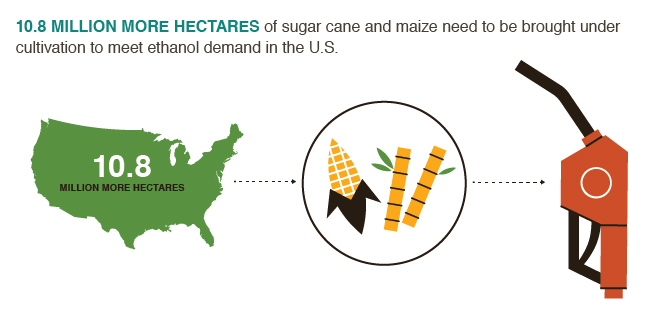Biofuels

Facts
- Global ethanol and biodiesel production is predicted to expand from 113 billion litres a year in 2012 to 180 billion litres a year in 2021 (OECD-FAO 2012). The largest markets—the United States, Brazil and the European Union—will grow at a slower pace than in recent years (USDA 2011).
- Ethanol prices are expected to increase from USD 0.85 per litre in 2012 to USD 0.95 per litre in 2021, while biodiesel prices are expected to increase from USD 1.53 in 2012 to USD 1.81 per litre in 2021.
- The continued expansion in biofuel production is largely the result of policies that encourage biofuel use, particularly use mandates and tax incentives (USDA 2011), and high crude oil prices.
- Using good cropland to expand production of liquid biofuel will likely exacerbate global warming in the same way as directly converting forest and grasslands (Searchinger et al. 2008 p. 1240). For example, increasing ethanol production by 56 billion litres would use the amount of maize grown on 12.8 million ha in the United States. This would require bringing an additional 10.8 million ha of land into cultivation to meet demand for maize for other uses (Searchinger et al. 2008 p. 1239).
- The two key factors that determine whether biofuels lead to lower or higher greenhouse gas emissions than fossil fuels are as follows (EEA 2011):
- How the biomass (the basis of the biofuel) is produced and harvested. This process could emit carbon through, for example, use of fertilizers and machinery.
- Where the biomass is produced. Biofuel production that leads directly or indirectly to land-use change emits large amounts of carbon.
Sources and further reading
- [EEA] European Environment Agency. 2011. Opinion of the EEA scientific committee on greenhouse gas accounting in relation to bioenergy. Copenhagen: European Environment Agency. (Available from http://www.eea.europa.eu/about-us/governance/scientific-committee/sc-opinions/opinions-on-scientific-issues/sc-opinion-on-greenhouse-gas/view) (Accessed on 6 November 2013)
- [OECD-FAO] Organisation for Economic Co-operation and Development-Food and Agriculture Organization of the United Nations. 2012. OECD-FAO Agricultural Outlook 2012. Paris: OECD and Rome: FAO. (Available from http://dx.doi.org/ 10.1787/agr_outlook-2012-en) (Accessed on 6 November 2013)
- Searchinger T, Heimlich R, Houghton RA, Dong F, Elobeid A, Fabiosa J, Tokgoz S, Hayes D, Yu T-H. 2008. Use of U.S. croplands for biofuels increases greenhouse gases through emissions from land-use change. Science 319(5867):1238-1240. (Available from http://dx.doi.org/10.1126/science.1151861)
- [USDA] United States Department of Agriculture. 2011. USDA Agricultural projections to 2020. Washington, DC: Economic Research Service, USDA. (Available from http://www.ers.usda.gov/publications/oce-usda-agricultural-projections/oce-111.aspx) (Accessed on 6 November 2013)